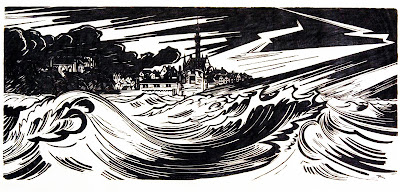(Java 1873 - 1940 Veere)
Royal Dutch Indies officer,
painter and graphic artist.
painter and graphic artist.
Are you in
for a treat ? Today I'll present to you my
most recent encounter in the world of printmaking. I had seen one or two examples of ten Kloosters' printmaking
skills before. In the 1927 Studio and Malcolm Salamans “Art of the Woodcut, Masterworks from the 1920’s” for example. In it Salaman writes highly of the quality of his prints. And in 2007 ten_Klooster
was awarded an exhibition in the Tropen Museum in Leiden, Netherlands. I missed
it, but today I share a selection of his finest prints. Click all pictures to embiggen.
Born from a
Dutch father and a Javanese-Chinese mother in Java, Netherlands Indie (Indonesia) Johannes ten_Klooster followed a military education and
career in Sumatra and later in what is now called Irian Jaya, In those days the province of Papua.
Retiring in 1918, at 45, and moving to the historical town of Veere, Zealand, in the land of ancestors, the Netherlands, he started a new
career as an artist. On leave in 1907 in the Netherlands he had received painting lessons
from Dutch painter Willem Adriaan Konijnenburg (1868-1943). And painting he did between 1907 and 1918 in Papua. Some of his best paintings were made there on location.
But most of his
paintings and woodcuts of tropical scenery, exotic people, dancers and fishermen, were created in the Netherlands either
from memory or from sketches he had made earlier. All the more remarkable.
He
developed very much his own style and was invited (only the most prominent artists were) creating this cover for “Wendingen” in 1928. In its days the
most prestigious Dutch art Magazine (above).
Hendrik
Willem van Loon (1882-1944) a Cornell professor, (American citizen in 1919) journalist and between the great
Wars America’s most famous Dutchman was ten_Klooster’s neighbour in Veere between 1927-1932. Himself a
writer, publicist and illustrator he also spoke very highly of ten_Kloosters Asian
modesty, his originality, craftsmanship and artistic talents in the July 1930
volume of the Forum magazine (the magazine was ended 1930).
The reason
why so little of his work is seen in public probably is because most of it is kept hidden in museum collections all over the world. I found several in the British
Museum but also in Australia, New-Zealand and the City of the Hague Museum
(Haags Gemeente Museum).
 |
| North Sea storm over Veere, Zeeland provice, Netherlands |
And the Tropen Museum holds some 30 of his prints. Together with the 2007 exhibition
a book was published with an index to the 178 (!) woodcuts he produced between 1918 and 1940. Van
Loon brought some to the USA in the 1930's as he proudly states in his Forum article.
Although
the signature is faded beyond recognition I’m now convinced my 1922 resting tiger print (read here) wich I discovered last year is also by Johannes ten Klooster. I’ve already found
an affordable copy of the book and will let you know soonest.
Roses thrive on sunshine, deserts on drought, babies on milk and alcoholics on beer. Bloggers, like ordinary humans, thrive on interaction and feedback. Consider leaving a comment if you've enjoyed (or used) the contents of this posting.
Roses thrive on sunshine, deserts on drought, babies on milk and alcoholics on beer. Bloggers, like ordinary humans, thrive on interaction and feedback. Consider leaving a comment if you've enjoyed (or used) the contents of this posting.












.jpg)
Although these are not really to my taste they are pretty good and I have always like the tiger. I'm not sure how you find these things.
ReplyDeleteHi there Charles, Oh yes I like them, because he's very original too. I've found a catalogue and will let you know were in his work the Tiger print fits in. The dark-light excecution of the forest voliage is very strong in that perticular print. It's a little like M.C. Escher, the way he works from dark to light from left to right.
ReplyDeleteWell, yes, the use of black and white is subtle yet rather stark. I suppose it's very different from the white line stuff we are uswed to in the UK.
ReplyDeleteI knew you would come round having a second look. They are indeed very different but they differ as much from contemporary continental printmakers. Maybe when I see the catalogue resumé I can tell you more about the way his printmaking evolved because different styles are also evident within his work. Will let you know.
ReplyDeleteI enjoy reading your articles and learning about artist that I have never heard of.
ReplyDeleteThank you Lorna, besides my own pleasure of making them that was exactly the purpose of starting the Linosaurus. Comments like yours are very encouraging and keeping me going. Stay tuned !
ReplyDelete